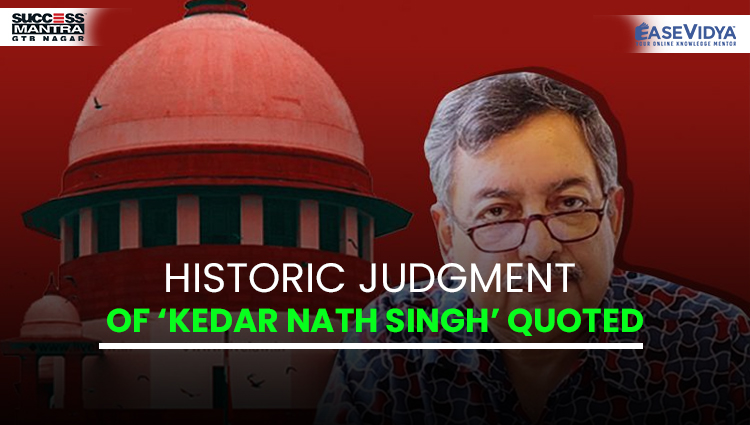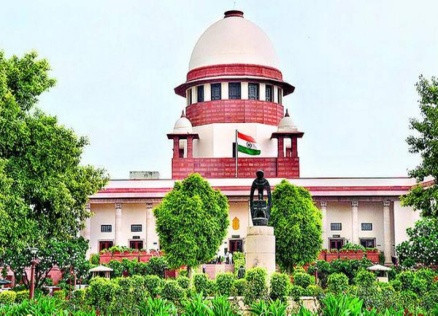
HISTORIC JUDGMENT OF KEDAR NATH SINGH QUOTED
HISTORIC JUDGMENT OF ‘KEDAR NATH SINGH’ QUOTED

The Supreme Court of India quashed the sedition case registered against journalist Vinod Dua in Shimla, Himachal Pradesh after a year of an FIR lodged by a local BJP leader over Dua’s YouTube show. BJP Mahasu unit President Ajay Shyam lodged a complaint against Dua stating that the journalist made allegations on his YouTube show on March 30 accusing Prime Minister Narendra Modi of using ‘deaths and terror attacks’ to garner votes. Dua was charged under sections 268, (public nuisance), 124A (sedition), 505 (statements conducive to public mischief), and 501 (printing matter known to be defamatory).
A bench of justices Vineet Saran and U U Lalit on had reserved the verdict after hearing the arguments for Vinod Dua, the complainant, and the Himachal Pradesh government. The bench stated that ‘Every journalist is entitled to protection under the Kedar Nath Singh judgement, the landmark verdict of 1962 on the scope of offense of sedition in the IPC.” In 1962, the Supreme Court while upholding the validity of Section 124A (sedition) of the IPC had ruled that sedition charges cannot be invoked against a citizen on the grounds of criticism against the measures or actions of Government as it would stifle the right to freedom of speech and expression.
KEDAR NATH SINGH V. STATE OF BIHAR (1962)
In 1952, Kedar Nath Singh, a member of the Forward Communist Party from Bihar was convicted and imprisoned on sedition charges after he made a fiery speech against the then ruling Congress during a rally at Begusarai. Singh then made an appeal to the Supreme Court in 1962 questioning the constitutional validity of Section 124A. He contended that his right to free speech under Article 19 of the Constitution was compromised. The Court was faced with a difficult task due to conflicting interpretations of Section 124A laid down by British era courts. The two previous judgements, one from 1942 and another from 1947, had contrasting views about the tendency to disturb public order or the incitement to violence were offenses under Section 124A.
HISTORIC JUDGEMENT OF KEDAR NATH SINGH

A Constitution Bench of the Supreme Court passed a landmark verdict upholding the validity of Section 124A (sedition) of the IPC but simultaneously limiting the scope of offense of sedition in the IPC laid down by British-era law by stating that which acts count for sedition and which don’t. The five-judges bench comprising Chief Justice BP Sinha, and Justices SK Das, N Rajagopala Ayyangar, JR Mudholkar, and AK Sarkar said that any act that has the effect to subvert the Government by violence or creating public disorder would be counted as sedition. The bench also upheld Section 505 (statements conducive to public mischief) as a constitutionally valid offense.
The Bench ruled that acts, within Section 124A, that create the feeling of contempt or hatred or disaffection or disloyalty against the Government would be given penal statute. Any spoken or written words that give out the idea of subverting the Government by violent means, which are included in the word ‘revolution’ would attract penal offense. However, the top court also ruled that comments expressing disapproval about the measures of government, with a view to improvement or alteration by lawful means, without inciting feelings of violence, disloyalty, or enmity are not sedition. The top court ruled further that a citizen has a right to write or say whatever he or she likes about the Government, or its measures, by way of criticism or comment, as long as he or she does not create public disorder or incite people to violence against the Government established by law.
However, in the case of Kedar Nath Singh v State of Bihar (1962), the top Court while upholding the validity of Section 124A (sedition) of the IPC, rejected the appeal of Kedar Nath on the grounds that his speech was a vilification of the Government filled with incitement to revolution and was not just criticizing the measures of the Government.
HISTORICAL BACKGROUND OF SEDITION LAW

Sedition laws were enacted in 17th century England when lawmakers believed that only good opinions of the government should survive, as bad opinions were detrimental to the government and monarchy. The law was originally drafted in 1837 by Thomas Macaulay, the British historian-politician, but was inexplicably omitted when the Indian Penal Code (IPC) was enacted in 1860. Section 124A was inserted in 1870 by an amendment introduced by Sir James Stephen when it felt the need for a specific section to deal with the offence. It was one of the many draconian laws enacted to stifle any voices of dissent at that time.
Sedition Law Today: Sedition is a crime under Section 124A of the Indian Penal Code (IPC). It defines sedition as an offence committed when "any person by words, either spoken or written, or by signs, or by visible representation, or otherwise, brings or attempts to bring into hatred or contempt, or excites or attempts to excite disaffection towards the government established by law in India". Disaffection includes disloyalty and all feelings of enmity. However, comments without exciting or attempting to excite hatred, contempt or disaffection, will not constitute an offence under this section.
Punishment for the Offence of Sedition: Sedition is a non-bailable offence. Punishment under the Section 124A ranges from imprisonment up to three years to a life term, to which fine may be added. A person charged under this law is barred from a government job. They have to live without their passport and must produce themselves in the court at all times as and when required.
MAJOR SC DECISION ON SEDITION LAW
The SC highlighted debates over sedition in 1950 in its decisions in Brij Bhushan vs the State of Delhi and Romesh Thappar vs the State of Madras. In these cases, the court held that a law which restricted speech on the ground that it would disturb public order was unconstitutional. It also held that disturbing the public order will mean nothing less than endangering the foundations of the State or threatening its overthrow. Thus, these decisions prompted the First Constitution Amendment, where Article 19 (2) was rewritten to replace “undermining the security of the State” with “in the interest of public order”. In 1962, the SC decided on the constitutionality of Section 124A in Kedar Nath Singh vs State of Bihar. It upheld the constitutionality of sedition, but limited its application to “acts involving intention or tendency to create disorder, or disturbance of law and order, or incitement to violence”. It distinguished these from “very strong speech” or the use of “vigorous words” strongly critical of the government. In 1995, the SC, in Balwant Singh vs State of Punjab, held that mere sloganeering which evoked no public response did not amount to sedition.
TEST YOURSELF
Q.1 Sedition has been defined as bringing or attempt to bring hatred or contempt, or exciting or attempt to excite disaffection towards the Government established by law in India, by words, either spoken or written, or by signs or visible representation or otherwise, under:
- Section 120 of IPC
- Section 120A of IPC
- Section 121A of IPC
- Section 124A of IPC: ANSWER
Q.2 Recently, which of the following historical judgment has been quoted by the Supreme Court in the sedition case registered against journalist Vinod Dua?
- Vishaka and others v. State of Rajasthan
- SR Bommai v. Union of India
- Kedar Nath Singh v. State of Bihar: ANSWER
- None of the above
Q.3 Consider the given statements & state which of the following is/are correct in the reference to the above mentioned passage?
- Section 121A of the IPC which defines has its utility in combating anti-national, secessionist and terrorist elements & It also protects the elected government from attempts to overthrow the government with violence and illegal means.
- Sedition is a bailable offence & Punishment under the Law of Sedition ranges from imprisonment up to three years to a life term.
- Only I follows
- Only II follows
- Both I & II follows
- None of the following: ANSWER
Q.4 Which of the following given statements can be considered as punishable under the Law of Sedition?
- Bitter Criticism of the government to overthrow it.
- Inducing people to cease to obey the law and lawful authority: ANSWER
- A publicist attack on the policies of the government.
- An attempt to remove the ministers from power.
Q.5 Which of the following is defined as attempting to overthrow the government of which one is a citizen or betraying that government to a foreign power?
- Espionage
- Conspiracy
- Sedition
- Treason: ANSWER












dtrzxhhim
HISTORIC JUDGMENT OF ‘KEDAR NATH SINGH’ QUOTED The Supreme Court of India quashed the sedition case registered against journalist Vinod Dua in Shimla, Himachal Pradesh after a year of an FIR lodged by a local BJP leader over Dua’s YouTube show. BJP Mahasu unit President Ajay Shyam lodged a complaint against Dua stating that the journalist made allegations on his YouTube show on March 30 accusing Prime Minister Narendra Modi of using ‘deaths and terror attacks’ to garner votes. Dua was charged under sections 268, (public nuisance), 124A (sedition), 505 (statements conducive to public mischief), and 501 (printing matter known to be defamatory). A bench of justices Vineet Saran and U U Lalit on had reserved the verdict after hearing the arguments for Vinod Dua, the complainant, and the Himachal Pradesh government. The bench stated that ‘Every journalist is entitled to protection under the Kedar Nath Singh judgement, the landmark verdict of 1962 on the scope of offense of sedition in the IPC.” In 1962, the Supreme Court while upholding the validity of Section 124A (sedition) of the IPC had ruled that sedition charges cannot be invoked against a citizen on the grounds of criticism against the measures or actions of Government as it would stifle the right to freedom of speech and expression. KEDAR NATH SINGH V. STATE OF BIHAR (1962) In 1952, Kedar Nath Singh, a member of the Forward Communist Party from Bihar was convicted and imprisoned on sedition charges after he made a fiery speech against the then ruling Congress during a rally at Begusarai. Singh then made an appeal to the Supreme Court in 1962 questioning the constitutional validity of Section 124A. He contended that his right to free speech under Article 19 of the Constitution was compromised. The Court was faced with a difficult task due to conflicting interpretations of Section 124A laid down by British era courts. The two previous judgements, one from 1942 and another from 1947, had contrasting views about the tendency to disturb public order or the incitement to violence were offenses under Section 124A. HISTORIC JUDGEMENT OF KEDAR NATH SINGH A Constitution Bench of the Supreme Court passed a landmark verdict upholding the validity of Section 124A (sedition) of the IPC but simultaneously limiting the scope of offense of sedition in the IPC laid down by British-era law by stating that which acts count for sedition and which don’t. The five-judges bench comprising Chief Justice BP Sinha, and Justices SK Das, N Rajagopala Ayyangar, JR Mudholkar, and AK Sarkar said that any act that has the effect to subvert the Government by violence or creating public disorder would be counted as sedition. The bench also upheld Section 505 (statements conducive to public mischief) as a constitutionally valid offense. The Bench ruled that acts, within Section 124A, that create the feeling of contempt or hatred or disaffection or disloyalty against the Government would be given penal statute. Any spoken or written words that give out the idea of subverting the Government by violent means, which are included in the word ‘revolution’ would attract penal offense. However, the top court also ruled that comments expressing disapproval about the measures of government, with a view to improvement or alteration by lawful means, without inciting feelings of violence, disloyalty, or enmity are not sedition. The top court ruled further that a citizen has a right to write or say whatever he or she likes about the Government, or its measures, by way of criticism or comment, as long as he or she does not create public disorder or incite people to violence against the Government established by law. However, in the case of Kedar Nath Singh v State of Bihar (1962), the top Court while upholding the validity of Section 124A (sedition) of the IPC, rejected the appeal of Kedar Nath on the grounds that his speech was a vilification of the Government filled with incitement to revolution and was not just criticizing the measures of the Government. HISTORICAL BACKGROUND OF SEDITION LAW Sedition laws were enacted in 17th century England when lawmakers believed that only good opinions of the government should survive, as bad opinions were detrimental to the government and monarchy. The law was originally drafted in 1837 by Thomas Macaulay, the British historian-politician, but was inexplicably omitted when the Indian Penal Code (IPC) was enacted in 1860. Section 124A was inserted in 1870 by an amendment introduced by Sir James Stephen when it felt the need for a specific section to deal with the offence. It was one of the many draconian laws enacted to stifle any voices of dissent at that time. Sedition Law Today: Sedition is a crime under Section 124A of the Indian Penal Code (IPC). It defines sedition as an offence committed when [url=http://www.gvd8sj649cnvq5fn36090575l7z5z3dks.org/]udtrzxhhim[/url] dtrzxhhim http://www.gvd8sj649cnvq5fn36090575l7z5z3dks.org/ <a href="http://www.gvd8sj649cnvq5fn36090575l7z5z3dks.org/">adtrzxhhim</a>
fxlqjdxw
HISTORIC JUDGMENT OF ‘KEDAR NATH SINGH’ QUOTED The Supreme Court of India quashed the sedition case registered against journalist Vinod Dua in Shimla, Himachal Pradesh after a year of an FIR lodged by a local BJP leader over Dua’s YouTube show. BJP Mahasu unit President Ajay Shyam lodged a complaint against Dua stating that the journalist made allegations on his YouTube show on March 30 accusing Prime Minister Narendra Modi of using ‘deaths and terror attacks’ to garner votes. Dua was charged under sections 268, (public nuisance), 124A (sedition), 505 (statements conducive to public mischief), and 501 (printing matter known to be defamatory). A bench of justices Vineet Saran and U U Lalit on had reserved the verdict after hearing the arguments for Vinod Dua, the complainant, and the Himachal Pradesh government. The bench stated that ‘Every journalist is entitled to protection under the Kedar Nath Singh judgement, the landmark verdict of 1962 on the scope of offense of sedition in the IPC.” In 1962, the Supreme Court while upholding the validity of Section 124A (sedition) of the IPC had ruled that sedition charges cannot be invoked against a citizen on the grounds of criticism against the measures or actions of Government as it would stifle the right to freedom of speech and expression. KEDAR NATH SINGH V. STATE OF BIHAR (1962) In 1952, Kedar Nath Singh, a member of the Forward Communist Party from Bihar was convicted and imprisoned on sedition charges after he made a fiery speech against the then ruling Congress during a rally at Begusarai. Singh then made an appeal to the Supreme Court in 1962 questioning the constitutional validity of Section 124A. He contended that his right to free speech under Article 19 of the Constitution was compromised. The Court was faced with a difficult task due to conflicting interpretations of Section 124A laid down by British era courts. The two previous judgements, one from 1942 and another from 1947, had contrasting views about the tendency to disturb public order or the incitement to violence were offenses under Section 124A. HISTORIC JUDGEMENT OF KEDAR NATH SINGH A Constitution Bench of the Supreme Court passed a landmark verdict upholding the validity of Section 124A (sedition) of the IPC but simultaneously limiting the scope of offense of sedition in the IPC laid down by British-era law by stating that which acts count for sedition and which don’t. The five-judges bench comprising Chief Justice BP Sinha, and Justices SK Das, N Rajagopala Ayyangar, JR Mudholkar, and AK Sarkar said that any act that has the effect to subvert the Government by violence or creating public disorder would be counted as sedition. The bench also upheld Section 505 (statements conducive to public mischief) as a constitutionally valid offense. The Bench ruled that acts, within Section 124A, that create the feeling of contempt or hatred or disaffection or disloyalty against the Government would be given penal statute. Any spoken or written words that give out the idea of subverting the Government by violent means, which are included in the word ‘revolution’ would attract penal offense. However, the top court also ruled that comments expressing disapproval about the measures of government, with a view to improvement or alteration by lawful means, without inciting feelings of violence, disloyalty, or enmity are not sedition. The top court ruled further that a citizen has a right to write or say whatever he or she likes about the Government, or its measures, by way of criticism or comment, as long as he or she does not create public disorder or incite people to violence against the Government established by law. However, in the case of Kedar Nath Singh v State of Bihar (1962), the top Court while upholding the validity of Section 124A (sedition) of the IPC, rejected the appeal of Kedar Nath on the grounds that his speech was a vilification of the Government filled with incitement to revolution and was not just criticizing the measures of the Government. HISTORICAL BACKGROUND OF SEDITION LAW Sedition laws were enacted in 17th century England when lawmakers believed that only good opinions of the government should survive, as bad opinions were detrimental to the government and monarchy. The law was originally drafted in 1837 by Thomas Macaulay, the British historian-politician, but was inexplicably omitted when the Indian Penal Code (IPC) was enacted in 1860. Section 124A was inserted in 1870 by an amendment introduced by Sir James Stephen when it felt the need for a specific section to deal with the offence. It was one of the many draconian laws enacted to stifle any voices of dissent at that time. Sedition Law Today: Sedition is a crime under Section 124A of the Indian Penal Code (IPC). It defines sedition as an offence committed when <a href="http://www.gs9en419x62dkg79n6y00dx4xk1767bos.org/">afxlqjdxw</a> fxlqjdxw http://www.gs9en419x62dkg79n6y00dx4xk1767bos.org/ [url=http://www.gs9en419x62dkg79n6y00dx4xk1767bos.org/]ufxlqjdxw[/url]
rsrssyjctb
Latest News on Education & LAW Exams Blogs | Success Mantra [url=http://www.g53mi8x307npvro7j26x8ed43js0957us.org/]ursrssyjctb[/url] rsrssyjctb http://www.g53mi8x307npvro7j26x8ed43js0957us.org/ <a href="http://www.g53mi8x307npvro7j26x8ed43js0957us.org/">arsrssyjctb</a>
gfyqczwjbf
Latest News on Education & LAW Exams Blogs | Success Mantra <a href="http://www.g1g79wy172x3rnt64hcgk5c7e63kw497s.org/">agfyqczwjbf</a> [url=http://www.g1g79wy172x3rnt64hcgk5c7e63kw497s.org/]ugfyqczwjbf[/url] gfyqczwjbf http://www.g1g79wy172x3rnt64hcgk5c7e63kw497s.org/
ewnghhclz
Latest News on Education & LAW Exams Blogs | Success Mantra ewnghhclz http://www.gd302f2s3pa0v496mytq55a99so68sj4s.org/ [url=http://www.gd302f2s3pa0v496mytq55a99so68sj4s.org/]uewnghhclz[/url] <a href="http://www.gd302f2s3pa0v496mytq55a99so68sj4s.org/">aewnghhclz</a>
yhggdhsdcd
Latest News on Education & LAW Exams Blogs | Success Mantra [url=http://www.g53dj2a4kzyi62p491x0ht88k54ndm68s.org/]uyhggdhsdcd[/url] <a href="http://www.g53dj2a4kzyi62p491x0ht88k54ndm68s.org/">ayhggdhsdcd</a> yhggdhsdcd http://www.g53dj2a4kzyi62p491x0ht88k54ndm68s.org/